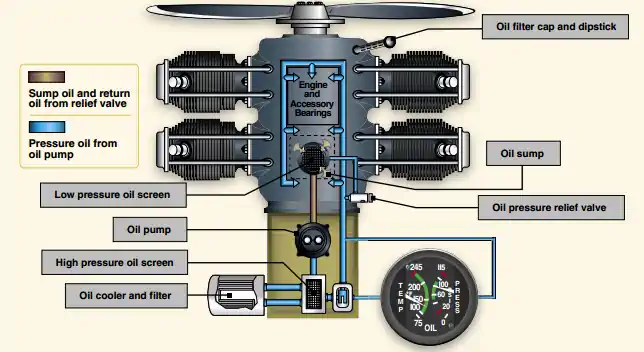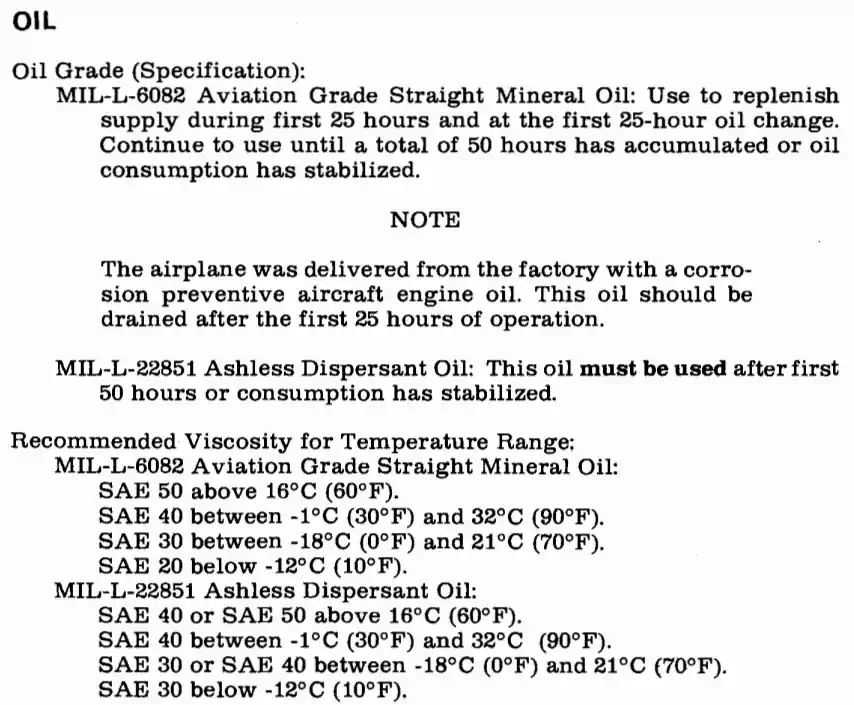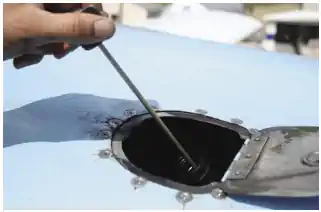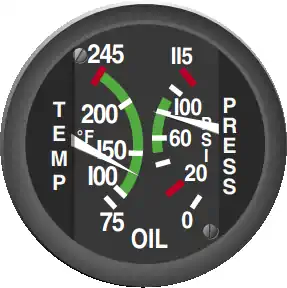Oil/Lubrication System
Oil lubricates moving parts, cools the engine by reducing friction, and creates better seals, improves engine efficiency and longevity.
Aviation Oil/Lubrication System
Aviation Oil/Lubrication System Introduction
- Lubrication systems are responsible for lubrication, heat management, and collecting debris that result from operation of the powerplant/engine.
- Wet and Dry oil/lubrication systems keep aircraft well-oiled while maintaining proper operating temperature.
- Depending on the aircraft, oil also powers other systems and accessories.
- When you feel you have a solid understanding of aviation oil/lubrication systems, compare your knowledge against the oil/lubrication related airman certification standards.
- Once satisfied, close out with the topic summary and prepare for your next lesson.
Aviation Oil/Lubrication System
Oi/Lubrication System Design
- Lubrication systems consist of either a wet-sump or a dry-sump system.
- To differentiate between the two systems, think about what happens when the engine is off.
- Wet sump systems maintain oil in reservoirs/oil pans (sumps) integral to the engine while dry sumps do not, leaving the sump "dry."
-
Wet-Sump Oil/Lubrication Systems:
- In a wet-sump system, an integral reservoir stores oil. [Figure 1]
- The main component is the oil pump, which pumps oil from the sump and routes it to the engine.
- After the oil circulates throughout the engine, it returns to the sump.
- In some engines, additional lubrication occurs by the rotating crankshaft, which splashes oil (splash lubrication) onto various engine components.
-
Dry-Sump Oil/Lubrication Systems:
- Oil is contained in a separate tank and circulated through the engine by pumps.
- These tanks are always larger than the oil it is meant to contain to compensate for thermal expansion.
- An oil pump also supplies oil pressure in a dry-sump system, but the source of the oil is located externally to the engine in a separate oil tank.
- After oil circulates through the engine, it is pumped from the various locations in the engine back to the oil tank by scavenge pumps.
- Dry-sump systems allow for a greater volume of oil to be supplied to the engine, which makes them more suitable for very large reciprocating engines.
- Most jet engines will consist of a dry sump design.
- When checking the oil level on a dry-sump engine that has been sitting idle, readings may be inaccurate unless rotated (or "burped").
- Refer to your POH.
Aviation Oil/Lubrication System
Lubrication System Components
-
Oil Filter:
- The oil filter is responsible for screening the oil for foreign debris.
- Oil filters accomplish this by pushing oil through a one or more screens or paper filters.
-
Oil Screens:
- There are two types of oil screens:
- Pressure Screens, or;
- Suction Screens.
-
Suction Screens:
- Suction screens are screens placed before the oil pump in the lubrication system , filtering out the largest contaminents before they enter delicate system components.
-
Pressure Screens:
- Pressure screens filter finer particulates, down to 60 microns.
- There are two types of oil screens:
-
Paper Oil Filters:
- Paper oil filters are a newer technology in which paper completes the functions of an oil screen.
-
-
Oil Filler Cap/Dipstick:
- The oil filler cap/dipstick used to measure oil quantity is usually accessible through a panel in the engine cowling. [Figure 2]
- If the quantity does not meet the manufacturer's recommended operating levels, oil should be added.
- If oil is unexpectedly low, the source of oil burn/leak should be investigated.
-
Oil:
- The type of oil required may vary on numerous atmospheric and operation conditions, as stipulated by the aircraft operations manual. [Figure 3]
- The AFM/POH or placards near the access panel provide information about the correct oil type and weight, as well as the minimum and maximum oil quantity.
- The loss of engine oil pressure would lead to engine vibrations, RPM would decrease, and the engine would eventually seize.
- Viscosity: the ability of a liquid to resist flow.
Aviation Oil/Lubrication System
Heat Management
- A critical purpose of engine oil is to help manage cooling.
- This occurs by cool oil moving through warm areas, picking up the heat, and dissipating it through a radiator.
Aviation Oil/Lubrication System
Oil System Gauges
- System is monitored through pressure and temperature gauges [Figure 4]
-
Oil Pressure Gauge:
- The oil pressure gauge provides a direct indication of the oil system operation. [Figure 4]
- It ensures the pressure in pounds per square inch (psi) of the oil supplied to the engine.
- Green indicates the normal operating range, while red indicates the minimum and maximum pressures.
- There should be an indication of oil pressure during engine start.
- Refer to the AFM/POH for manufacturer limitations.
-
Oil Temperature Gauge:
- The oil temperature gauge measures the temperature of oil. [Figure 4]
- It is usually measured after passing through the oil cooler.
- A green area shows the normal operating range and the red line indicates the maximum allowable temperature.
- Unlike oil pressure, changes in oil temperature occur more slowly.
- This is particularly noticeable after starting a cold engine, when it may take several minutes or longer for the gauge to show any increase in oil temperature.
- Check oil temperature periodically during flight especially when operating in high or low ambient air temperature.
- High oil temperature indications may signal:
- Plugged oil line or cooler.
- low oil quantity (possible engine failure).
- Defective temperature gauge.
- High oil temperatures can lead to metal on metal contact as viscosity decreases.
- Low oil temperature indications may signal improper oil viscosity during cold weather operations.
Aviation Oil/Lubrication System
Oil/Lubrication Malunfctions/Emergencies
- Oil consumption depends primarily upon the efficiency of the seals.
- Oil can be lost through internal leakage, and, in some engines, by malfunctioning of the pressurizing or venting system.
- Increases in oil temperature are not always associated with a drop in oil pressure, nor a rise in CHTs.
-
Low Oil Pressure:
- Low oil pressure can be caused by an oil leak which leads to lack of oil in the system, or an ineffective oil pump.
- These emergencies can be particularly detrimental when flying an aircraft utilizing a constant-speed propeller.
-
Low Oil Pressure Primary Indications:
- Oil pressure will indicate low.
-
Low Oil Pressure Secondary Indications:
- Rising Cylinder Head Temperatures (CHT).
- Oil temperature may rise (if the pressure drops rapidly then it is less likely you will have a corresponding temperature indication.
- Rough engine indications.
-
Low Oil Temperature:
Primary Indications:
- Oil temperature will indicate low.
Secondary Indications:
-
High Oil Temperature:
-
High Oil Temperature Primary Indications:
- Oil temperature will indicate high.
-
High Oil Temperature Secondary Indications:
- Other temperatures will indicate high.
- Possible smoke.
- Low oil pressure.
- High RPM.
-
High Oil Temperature Considerations:
- Open cowl flaps, if equipped.
-
-
Oil Leaks:
- Oil on windscreen may come from engine or propeller.
Aviation Oil/Lubrication System
Oil System Inspections
- Inspecting the oil system is more than a routine check
- It is an opportunity for a detailed review of aircraft engine health.
-
Oil Inspection:
- Pilots should inspect the oil as part of the pre-flight checklist.
- Inspecting the oil is critical in determining the quantity and condition of oil.
- Oil should never go below the Pilot Operating Handbook specified minimum quanty.
- The color of the oil is a reflection of oil age and engine health.
- New, clean oil should be light in color.
- Dark oil is generally the result of contaminates and oxidation after many hours of operation.
- Too dark is a judgement call based on the amount of hours of use.
- Dark oil may be due to bad piston seals.
- Larger oil sumps tend to absorb contaminents better as they hold more in suspension.
- Smaller sumps should therefore be changed/drained more often.
- Note that while wet-sump systems can be checked by simply checking the dip stick before flight, a dry-sump system may require the engine be turned a few times to circulate residual oil in the engine back to the sump.
- This may be referred to as "burping."
-
Oil Filter Inspection:
- It is never required, but pilots who own their airplane may elect to inspect the oil filter for tell-tale signs of wear.
- Oil filters are designed to bypass, if clogged, but are only meant to last for the life of the oil.
- Oil filters should be changed with every oil change.
- Changing an oil filter often also allows for consistent engine health trend analysis.
Aviation Oil/Lubrication System
Aviation Oil/Lubrication System Conclusion
- Oil systems reduce friction on moving parts, create better seals, reduce and remove heat, carry away contaminants and in some cases, run other systems.
- Oil can be sent off for analysis which checks small particles not caught by filter, but a filter will hide big issues.
- Many systems have pressurized sumps and a pressurized oil tank to ensure a constant head pressure to the lubrication pump to prevent pup cavitation at high altitudes.
- Changing oil is permitted as preventative maintenance and provides an indication of engine health.
- Oil consumption is relatively low in a gas turbine engine compared to a piston-type engine.
- Still looking for something? Continue searching:
Aviation Oil/Lubrication System



